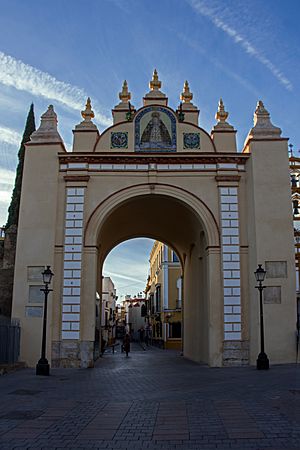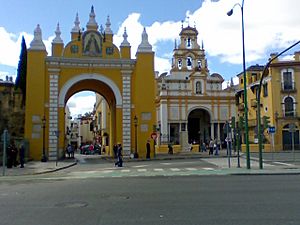Macarena Gate facts for kids
The Puerta de la Macarena, also known as the Arco de la Macarena, is one of only three city gates left from the old Walls of Seville. The other two are the Postigo del Aceite and the Puerta de Córdoba. This historic gate is located in the Resolana Street in the San Gil neighborhood, which is part of Seville's Old Town district in Andalusia, Spain.

The gate faces the Basílica de La Macarena, a famous church that holds the image of the Our Lady of la Esperanza Macarena. This image is very important during Holy Week in Seville. The Puerta de la Macarena is the northernmost and largest gate of the city's old walls. It's one of the few parts of the ancient defenses that still stand today.
The original city walls were built by the Romans during the time of Julius Caesar. The Puerta de la Macarena itself was part of a big expansion of the walls in the 12th century by Sultan Ali ibn Yusuf. Its current look comes from changes made between 1723 and 1795. These changes gave it the classic style you see today, replacing its older Islamic design.
Historically, this gate was very important. Kings visiting Seville for the first time would enter through it. They would stop at an altar outside the gate to pay their respects and receive the city's keys. Kings like Alfonso XI of Castile (1327), Isabella I of Castile (1477), Ferdinand II of Aragon (1508), Charles V, Holy Roman Emperor (1526), and Philip IV (1624) all followed this tradition.
Above the gate, there is a beautiful ceramic tile altarpiece. It shows the Virgin of Hope of Macarena and was created by the artist Manuel Rodríguez y Pérez de Tudela. This altarpiece was officially opened in 1923 by Princess Maria de la Esperanza of Bourbon-Two Sicilies. The gate and the remaining city walls were declared a Bien de Interés Cultural (a type of heritage site) in 1985.
Contents
Where is the Gate and What Does Its Name Mean?
The Puerta de la Macarena is located in what used to be the "Macarena suburb." It was the main northern entrance to the walled city. From here, an old path for mules led to Extremadura. Today, it stands on Resolana Street, across from the Basílica de La Macarena (built in 1941) and near the Hospital de las Cinco Llagas (which now houses the Parliament of Andalusia). It's in the San Gil neighborhood and the Old Town district.
There are different ideas about where the name "Macarena" comes from. Historians don't fully agree on one specific origin. Some very old theories suggest it comes from Greece, possibly linked to Macaria, a daughter of Hercules, who is said to have founded Seville. Other ideas point to a Roman origin, perhaps from a wealthy Roman named Macarius who owned land in the area.
However, the most common theory among historians is that the name comes from Arabic. It might be from a Moorish princess who lived near the wall, or from a Moorish man with the same name. An old writer named Alonso Morgado mentioned in 1587 that the gate got its name from a "main Moor called Macarena." This Moor would leave the city through this gate to reach his land. This Arab origin seems more likely because there was a place called qaryat Maqrana (the village of Macarena) nearby.
History of the Gate
Early Years (12th-15th Centuries)
The walls of Seville were first built by the Romans to replace older defenses. They were later expanded significantly in the 12th century by the Arabs under Sultan Ali ibn Yusuf. The Puerta de la Macarena likely dates from this Arab expansion. Some historians, however, believe it might be the only gate remaining from the original Roman walls built by Julius Caesar.
A famous legend tells that during the siege of Seville, King Ferdinand III of Castile prayed to the Virgin of the Kings for help. An angel supposedly led him into the city through the Puerta de Jerez to the main mosque. There, a wall became transparent, showing him the image of the Virgin of la Antigua. While the king was inside, Christian knights, including Diego López III de Haro and Rodrigo González Girón, entered the city through the Puerta de la Macarena to help him.
Later, in 1358, Infante Don Fadrique entered through this gate before being killed by his brother, Peter of Castile. In 1413, a monk named Diego de Sevilla returned to his hometown through this gate. The next year, he founded the Monastery of San Jerónimo de Buenavista just outside the gate.
In 1477, Queen Isabella I of Castile made a grand entrance into Seville through the Puerta de la Macarena. She arrived at ten in the morning and swore to respect the city's rights at a silver altar. The arch was beautifully decorated for her arrival. Many people, including city officials, church leaders, and ordinary citizens, came to see her. Her husband, King Ferdinand, was not with her as he was in Aragon. In 1491, the Catholic Monarchs decided that grain coming into the city could only enter through this gate, the Puerta de Triana, and the Puerta de Carmona.
Royal Entries and Changes (16th-18th Centuries)
In 1508, Ferdinand II of Aragon entered Seville through the gate with Germaine of Foix. For this event, triumphal arches were set up in Seville for the first time. His grandson, Charles V, Holy Roman Emperor, also arrived through this gate on March 10, 1526, to marry Isabella of Portugal. Seven triumphal arches were built to decorate the city for this grand welcome. The first one stood right behind the Puerta de la Macarena.
When King Philip II visited Seville in 1570, he did not enter through the Puerta de la Macarena. Instead, he used the Puerta de Goles because the streets around Macarena were not in good condition. This was the only time a king did not use the Macarena gate for his official entry. However, his grandson, Philip IV, brought back the tradition. On March 1, 1624, he made his public entry into the city through the gate.
The Seville city council made improvements to the gate in 1561. In 1630, a stone tablet was placed on the gate. It reminded the gatekeepers not to leave their posts. This tablet is still there today. During a terrible plague in 1646, one of the new cemeteries for the many dead was set up outside the gate. The gate was also famous enough to inspire a play called La puerta Macarena by Juan Pérez de Montalbán in the 17th century.
The gate was renovated in 1723 and then rebuilt in 1795 by architect José Chamorro. This last renovation removed its old Arab look and gave it the classic style it has today.
Modern Times (19th-21st Centuries)
In 1836, during the Carlist wars, a moat and drawbridge were added to strengthen the gate. It was later renovated, and an altarpiece of the Virgin of Sorrows was removed from inside. On July 17, 1854, General Leopoldo O'Donnell entered the city through this arch.
After the revolution of 1868, the city walls of Seville began to be torn down. This work finished in 1873. However, the Macarena walls were saved because a special committee argued for their historical value. Despite this, the city council still wanted to remove them. In 1908, the section of the wall between the Puerta de la Macarena and the Puerta de Córdoba was declared a National Monument. Even so, in 1909, the city council still considered demolishing parts of it for urban development.
The arch is very closely linked to the image of the Holy Mary of la Esperanza Macarena and her brotherhood. Every year, during the early hours of Good Friday, the brotherhood's procession passes through this gate. Because of this strong connection, a ceramic altarpiece showing the Virgin was placed on the gate in 1922. It was opened on May 27, 1923, by Princess Maria de la Esperanza of Bourbon-Two Sicilies.
During the uprising of 1936, the arch was hit by gunshots. Its wall was also used as a firing squad location, where many people were shot.
In 1985, the gate and the remaining city walls were again declared a Bien de Interés Cultural (a protected monument). Ten years later, in 1995, the Macarena brotherhood held a very special procession through the gate. This was to celebrate 400 years since the brotherhood was founded. The Princess Maria de la Esperanza of Bourbon-Two Sicilies, who had opened the altarpiece 72 years earlier, attended this event.
The last major repair to the gate happened in 1998. This involved archaeological work to strengthen the arch, which was in poor condition.
Today, people often call it the "Arch of Macarena" instead of the "Gate of Macarena." It has become a symbol for its neighborhood. Its strong connection with the Macarena Brotherhood and the universally loved image of the Our Lady of la Esperanza Macarena has made the arch very popular. Hundreds of people gather there during Holy Week in Seville to watch the image pass under the arch. In 2012, the Spanish postal service, Correos, even featured the Puerta de la Macarena on one of its stamps in a series about monumental arches and gates.
See also
 In Spanish: Puerta de la Macarena para niños
In Spanish: Puerta de la Macarena para niños


